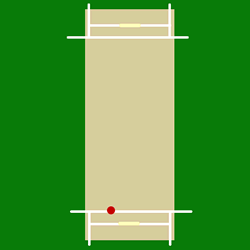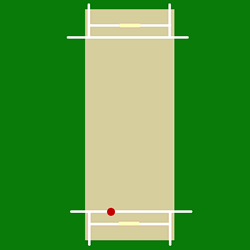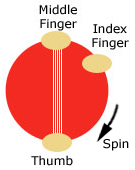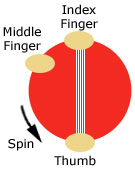
Leg spin is a type of spin bowling in cricket. A leg spinner bowls right-arm with a wrist spin action. The leg spinner's normal delivery causes the ball to spin from right to left when the ball bounces on the pitch. For a right-handed batter, that is away from the leg side, and this is where it gets the name leg break.

Left-arm unorthodox spin, also known as slow left-arm wrist spin, is a type of spin bowling in the sport of cricket. Left-arm unorthodox spin bowlers use wrist spin to spin the ball, and make it deviate, or 'turn' from left to right after pitching. The direction of turn is the same as that of a traditional right-handed off spin bowler, although the ball will usually turn more sharply due to the spin being imparted predominantly by the wrist.
The flipper is a particular bowling delivery used in cricket, generally by a leg spin bowler. In essence it is a back spin ball. Squeezed out of the front of the hand with the thumb and first and second fingers, it keeps deceptively low after pitching and can accordingly be very difficult to play. The flipper is comparable to a riseball in fast-pitch softball.

Off spin is a type of finger spin bowling in cricket. A bowler who uses this technique is called an off spinner. Off spinners are right-handed spin bowlers who use their fingers to spin the ball. Their normal delivery is an off break, which spins from left to right when the ball bounces on the pitch. For a right-handed batsman, this is from his off side to the leg side. The ball breaks away from the off side, hence the name 'off break'.
In the game of cricket, a googly refers to a type of delivery bowled by a right-arm leg spin bowler. It is different from the normal delivery for a leg-spin bowler in that it is turning the other way. The googly is not a variation of the typical off spin type of delivery, in that the cricket ball is presented from the bowler's hand in such a way that once the ball pitches; instead, it deviates in the opposite direction of a leg spinning type of delivery. It has also been colloquially referred to as the wrong'un, Bosie or Bosey, with the latter two eponyms referring to Bernard Bosanquet, the bowler who originally devised and began using the googly.

Bowling, in cricket, is the action of propelling the ball toward the wicket defended by a batter. A player skilled at bowling is called a bowler; a bowler who is also a competent batter is known as an all-rounder. Bowling the ball is distinguished from throwing the ball by a strictly specified biomechanical definition, which restricts the angle of extension of the elbow. A single act of bowling the ball towards the batsman is called a ball or a delivery. Bowlers bowl deliveries in sets of six, called an over. Once a bowler has bowled an over, a teammate will bowl an over from the other end of the pitch. The Laws of Cricket govern how a ball must be bowled. If a ball is bowled illegally, an umpire will rule it a no-ball. If a ball is bowled too wide of the striker for the batsman to be able to play at it with a proper cricket shot, the bowler's end umpire will rule it a wide.
A topspinner is a type of delivery bowled by a cricketer bowling either wrist spin or finger spin. In either case, the bowler imparts the ball with top spin by twisting it with his or her fingers prior to delivery. In both cases, the topspinner is the halfway house between the stock delivery and the wrong'un - in the wrist spinner's case his googly, and in the finger spinner's case his doosra.

This is a general glossary of the terminology used in the sport of cricket. Where words in a sentence are also defined elsewhere in this article, they appear in italics. Certain aspects of cricket terminology are explained in more detail in cricket statistics and the naming of fielding positions is explained at fielding (cricket).
A doosra is a particular type of delivery by an off-spin bowler in cricket. The doosra spins in the opposite direction to an off break, and aims to confuse the batsman into playing an unavoidable shot.
Seam bowling is a bowling technique in cricket whereby the ball is deliberately bowled on to its seam, to cause a random deviation when the ball bounces. Practitioners are known as seam bowlers or seamers.

Spin bowling is a bowling technique in cricket, in which the ball is delivered relatively slowly but with the potential to deviate sharply after bouncing. The bowler is referred to as a spinner.
An arm ball is a type of delivery in cricket. It is a variation delivery bowled by an off spin bowler or slow left-arm orthodox bowler. It is the finger spin equivalent of a wrist spinner's slider or zooter.

A leg cutter is a type of delivery in the sport of cricket. It is bowled by fast bowlers.

An off cutter is a type of delivery in the game of cricket. It is bowled by fast bowlers.
In the sport of cricket, a slower ball is a slower-than-usual delivery from a fast bowler. The bowler's intention is to deceive the batsman into playing too early so that he either misses the ball completely or hits it high up in the air to offer an easy catch. It is analogous to a changeup in baseball.
Wrist spin is a type of bowling in the sport of cricket. It refers to the cricket technique and specific hand movements associated with imparting a particular direction of spin to the cricket ball. The other spinning technique, usually used to spin the ball in the opposite direction, is finger spin. Wrist spin is bowled by releasing the ball from the back of the hand, so that it passes over the little finger. Done by a right-handed bowler, this imparts an anticlockwise rotation to the ball, as seen from the bowler's perspective; a left-handed wrist spinner rotates the ball clockwise.
Finger spin is a type of bowling in the sport of cricket. It refers to the cricket technique and specific hand movements associated with imparting a particular direction of spin to the cricket ball. The other spinning technique, generally used to spin the ball in the opposite direction, is wrist spin. Although there are exceptions, finger spinners generally turn the ball less than wrist spinners. However, because the technique is simpler and easier to master, finger spinners tend to be more accurate.
In the sport of cricket, the bowling action is the set of movements that result in the bowler releasing the ball in the direction of the batsman.

In ball sports, topspin or overspin is a property of a ball that rotates forwards as it is moving. Topspin on a ball propelled through the air imparts a downward force that causes the ball to drop, due to its interaction with the air. Topspin is the opposite of backspin.
The teesra, also known as the jalebi, is a particular type of delivery by an off-spin bowler in the sport of cricket, which renowned off-spinner Saqlain Mushtaq said he had invented. However, upon closer inspection, the ball is simply an orthodox backspinner, a very common delivery that has been bowled by finger spinners as long as cricket has been played.







